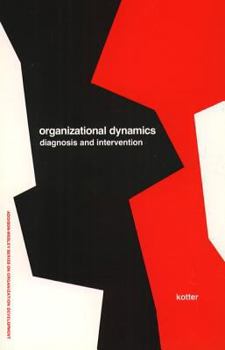Organizational Dynamics: Diagnosis and Intervention (Prentice Hall Organizational Development Series)
A member of the AWL OD Series This book offers managers and OD specialists a powerful way of diagnosing organizational problems and of deciding when, where, and how to use (or not use) the diverse and... This description may be from another edition of this product.
Format:Paperback
Language:English
ISBN:0201038900
ISBN13:9780201038903
Release Date:January 1978
Publisher:FT Press
Length:99 Pages
Weight:0.30 lbs.
Dimensions:0.3" x 5.3" x 8.2"
Customer Reviews
1 rating
The clearest explanation of systems thinking you can find!
Published by Thriftbooks.com User , 25 years ago
After extensive research in 1975 and 1976 of twenty-six organizations, Kotter developed a model to supplement or replaces other diagnosis models of the time. His criteria for determining the elements was support for their importance from convincing research literature; that they were mutually exclusive and collectively exhaustive; and they illustrate the dynamic life cycle of a real organizations. The purpose of his model is to integrate common findings among several fragmented and often opposing studies. The model contains seven major conceptual elements that can describe most organizations from the simplest to the most complex.In its time, Kotter's model was quite unique and revolutionary. He broached the concepts of systems thinking with his cause and effect analysis, alignment/non-alignment, and homeostatic driving force aspects long before experts and researchers were considering it important to analyze all of the seven elements and their relationship. Kotter's model probably met with some severe resistance from experts who had been analyzing and creating models for organizations for years. Other consultants did not begin to think systemically for at least another decade. His intent was to create model to fill in the gaps and cross lines that other models were not designed to handle. Like any well-developed model, I believe this model will stand the test of time and evolution. The model still has the criteria required to analyze and diagnose any organization in today's business world. It maps the life cycle of an open system, from the time the environment provides input, to the systems processing of that input, to the output for the environment to dispose. The model is simple enough that it requires minimal explanation to the client, yet detailed enough to capture virtually any variable that affects organization development and change. Questions developed with the model cover valid and reliable specifications for how a system should look when it is running efficiently. Most importantly, it reminds the user to analyze all facets of an organization to diagnose the problem instead of a symptom. Along with it's 90 page descriptive guidebook, the model is a practical way to grasp the philosophy, discipline and common pitfalls of effective diagnosis and intervention with minimal exposure to the process.





